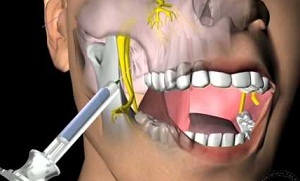 Anesthesia is an integral part of almost all dental manipulations. Painless is one of the main criteria for the effectiveness of treatment. In this way, the psychological comfort of the patient in the chair at the dentist is achieved.
Anesthesia is an integral part of almost all dental manipulations. Painless is one of the main criteria for the effectiveness of treatment. In this way, the psychological comfort of the patient in the chair at the dentist is achieved.
Infiltration anesthesia( in the common people "frost") is a form of local anesthesia, in which the blocking of nerve impulses occurs only at the site of injection of an anesthetic.
This is the most commonly used method of anesthesia used in dentistry. The anesthetic quickly penetrates deep into the tissues, blocks the nerves and the impulses emanating from them.
Anesthetic effect occurs in 5-7 minutes. And its duration is 1-1.5 hours.
Content
- anatomical overtones
- Indications for use
- According Vishnevsky
- Technique
- What can be complications
- Advantages and disadvantages
- freezing technique in the maxilla
- Possible problems
- Advantages and disadvantages
- performing procedures on the lower jaw
- Subperiosteal freezing
- What is the consequence?
- Advantages and disadvantages of
- Soft facial analgesia method
- As an output of
Anatomical implication of
In infiltration anesthesia, the main amount of anesthetic is injected into the space between the gingival mucosa and the periosteum. Due to its porous structure, the active substance penetrates well to the nerve endings of the tooth, blocking them.
If a subperiosteal version of anesthesia has been selected, the depot is located between the bone and the periosteum. In this case, the anesthesia of 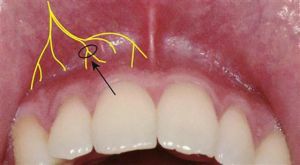 occurs somewhat faster, since the nerves are closer to the site of administration.
occurs somewhat faster, since the nerves are closer to the site of administration.
The rate of development of analgesic effect on the upper and lower jaw will be different. This is due to their structural features.
The compact plate of the upper jaw is less dense, so the required result will be achieved much faster. In addition, the zone of anesthesia is limited to premolars below. For the remaining teeth, conductive anesthesia is recommended.
An anesthetic effect zone will be limited to one, maximum of two teeth. The patient will not feel the gingival mucosa, the tooth tissue and the lip of the corresponding area.
Indications for use
The infiltration method of anesthesia is used in the following situations:
- caries therapy;
- treatment of the root canals of the tooth;
- periodontal surgery;
- pruning of bridles;
- opening of abscesses;
- tooth extraction;
- implantation;
- orthopedic treatment.
According to Vishnevsky
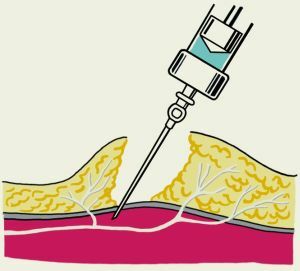 Infiltration anesthesia according to Vishnevsky is distinguished among others in that anesthetic penetrates into tissues layer by layer. Each layer is anesthetized separately due to the so-called "creeping infiltrate".
Infiltration anesthesia according to Vishnevsky is distinguished among others in that anesthetic penetrates into tissues layer by layer. Each layer is anesthetized separately due to the so-called "creeping infiltrate".
This effect is achieved by injecting an anesthetic solution under pressure. The drug spreads through the tissue, which provides direct contact with the nerves of the operated area.
Technique for the procedure
Procedure:
- , first the anesthetic is injected into the skin where the lemon crust is formed - just on the line of the future incision, the needle should be at an angle of 90 degrees to the surface;
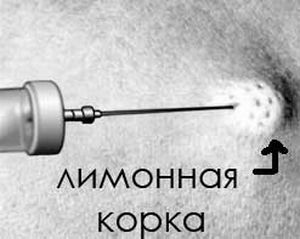
- then anesthesia is carried out under the skin of the cellulose;
- further cuts the surface tissues;
- the doctor then proceeds to anesthetize the connective tissue covering the muscle;
- then it is also cut, which provides access to the organ on which the main manipulation is performed.
Area of exposure is small. The anesthetic extends 3 cm from the site of penetration.
What complications can be
Complications that may occur:
- blood vessel damage;
- needle fracture;
- nerve damage.
Advantages and disadvantages of
Pros of this method:
- simple execution technique and safety;
- protective reflexes of the body are not oppressed;
- in hospital settings can be used for patients with severe somatic pathologies.
Cons:
- large consumption of auxiliary materials, since for each layer a new portion of anesthetic and scalpel should be used;
- can not be used in children.
Freezing technology on the upper jaw
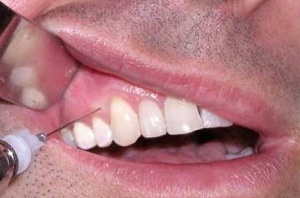 Thanks to the structure of bone tissue, the anesthetic effect on the upper jaw comes quickly enough. You can anesthetize this method with all your teeth.
Thanks to the structure of bone tissue, the anesthetic effect on the upper jaw comes quickly enough. You can anesthetize this method with all your teeth.
You can perform the procedure both from the side of the mouth and from the palate. The only difference is the amount of substance administered. In the sky, you can enter no more than 0.2-0.3 ml of the drug, since the submucosa is practically absent.
Technique of infiltration anesthesia on the upper jaw:
- with the help of a dental mirror, the doctor pulls the upper lip to the side, thereby creating a good visibility of the transitional fold;The
- needle is inserted at an angle of 45 degrees in the projection of the apex of the root of the tooth; it should move forward until it comes into contact with the bone;
- is then injected with the required amount of anesthetic;
- at the end of the needle is carefully removed from the tissues.
If an additional painless area is required from the palate, then another prick at the level of the tooth is made into an angle formed by the palatal and alveolar processes of the jaw.
After using anesthesia, the tooth is anesthetized, next to which an anesthetic was injected.
Possible problems of
The following complications may occur:
- vascular wall damage;
- bleeding;
- is a hematoma.
Advantages and disadvantages of
Pros:
- for achieving the optimum effect, even a small amount of anesthetic solution will suffice;
- low traumatic manipulation;
- quick receipt of the desired result;
: limited impact area.
Procedure on the lower jaw
In the lower jaw, only incisors, canines or premolars can be anesthetized by infiltration. In the region of molars, the cortical plate becomes so dense that it is impossible to spread the anesthetic through it.
Technique: 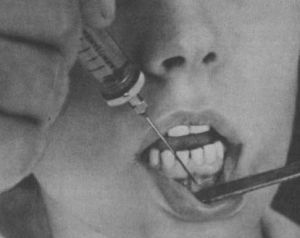
- , first the lower lip is drawn aside and an optimal view of the transitional fold is provided;
- injection is carried out in the projection of the apex of the tooth root in the transitional fold;
- needle moves to the bone, the main depot of anesthetic is produced;
- then the syringe is carefully removed.
Sometimes it is possible to add a medicine on the part of the tongue. Injection is also carried out in the transitional fold. The needle advances to a depth of 2 cm.
Anesthesia area, possible complications, advantages and disadvantages correspond to those in anesthesia of the upper jaw.
Subperiosteal freezing
When anesthetic solution is administered immediately under the periosteum, the effectiveness of the manipulation is increased. Penetration of the solution to the nerves occurs much faster than with the usual technique.
In this case, a short needle with a length of up to 3 cm is used.
Technical features:
- syringe is inserted into the area of transition of the mobile mucosa into a stationary one and advances until it comes into contact with the bone;
- is then injected with an anesthetic in a volume of 0.5 ml;
- after half a minute piercing periosteum at an angle of 45 degrees;
- the needle is moved towards the apex of the tooth root;
- further the main amount of the drug is injected in a volume of 1 ml.
Anesthetized tooth and mucous membrane around it.
What is fraught?
Possible complications:
- damage to blood vessels;
- periostitis;
- with excess of the injected anesthetic, the periosteum can be detached with the development of necrotic processes.
Advantages and disadvantages of
Pros:
- higher efficiency;
- anesthetic is more localized and less likely to penetrate the nerve endings of other teeth.
Cons:
- execution technique is less simple;
- has the risk of damaging the periosteum.
Soft Facial Softening Technique
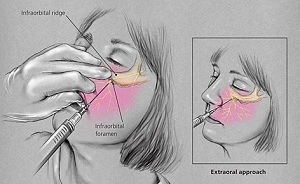 Soft tissue anesthesia is performed according to the Vishnevsky method. This option is used for small surgical operations on the face, for example, at the opening of purulent abscesses that are under the skin, or when excising new growths.
Soft tissue anesthesia is performed according to the Vishnevsky method. This option is used for small surgical operations on the face, for example, at the opening of purulent abscesses that are under the skin, or when excising new growths.
The procedure of implementation corresponds to that for the standard infiltration anesthesia according to Vishnevsky. Stages:
- introduction of the first portion of the preparation around the future incision;
- is then cut into the skin;
- further, using a longer needle, the anesthetic is introduced into the subcutaneous tissue;
- it is cut in the same way;
- then the syringe is injected into the muscular fascia, which is also excised.
Soft tissues are anesthetized in the area of the formation that is subsequently excised.
Complications, plus the pros and cons of this method, correspond to those using the standard method.
Possible errors in execution:
- wrong angle of needle insertion, in this case the effect may not occur at all;
- needle fracture;
- infection of the tissues of the face and oral cavity;
- wrong choice of needle length;
- non-compliance with the execution stages.
As an output of
The advantages of local anesthesia with infiltration anesthesia include the following characteristics: 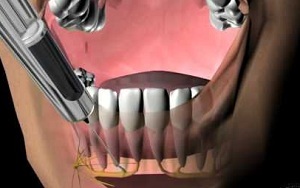
- safety of use for patients with somatic pathologies;
- effect occurs quickly, so therapeutic manipulation can begin earlier;
- always has the option of reintroduction;
- the rate of excretion of anesthetic agent is higher than with conventional conductive;
- ease of execution technique;
- is less likely to develop complications after manipulation.
Existing shortcomings:
- anesthesia zone is limited, so this method of blocking pain impulses can not be used for extensive manipulations;
- a limited amount of time to perform the intervention;
- bitter taste in the oral cavity, if the anesthetic has emerged from the area of administration.
Infiltrative anesthesia is a modern method of anesthesia, which is used in dentistry in most cases. A small number of complications and ease of execution make it safe for both the doctor and the patient.
